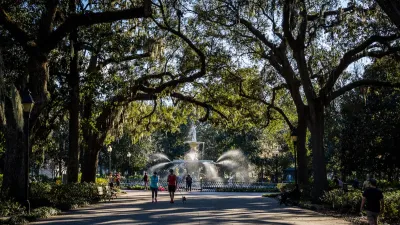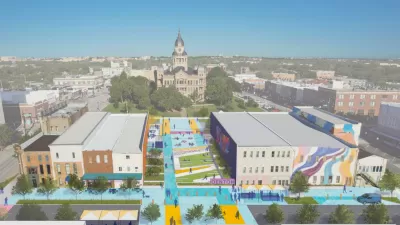The smart phones that keep us constantly connected to cyberspace may have detrimental effects on our public spaces, writes Emily Badger.
Remember the flip-phone glory days of just five years ago, when people in public spaces would make eye contact, ask for directions, or even say a friendly hello when passing by. Those days seem long gone, as smartphone use has created "portable private personal territories," in which fellow pedestrians are much more likely to be engrossed in checking their phones to see the new Facebook or Twitter update, read email, or send a text.
The change in mobile technology has prompted Tali Hatuka and Eran Toch from Tel Aviv University to study how phone users view their devices - and how they feel about the behavior of others. They've found that "Smart-phone users, for starters, are much more commonly under the illusion that they have privacy even when walking down a public sidewalk. They're less skittish about having personal conversations in public. They're more detached from their physical surroundings."
As smart phone users retreat into their own private spheres, public spaces suffer, notes Badger. "This is not a good thing. The public sphere plays an important role in our communities: it's where we observe and learn to interact with people who are different from us, or, as academics put it, it's where we come to know 'the other.'"
"The communication of strangers was always one of the key roles of public spaces, observing and exchanging with the other. Because smart phones are supplying so many of these services, this kind of exchange with the stranger is just diminished to almost zero," observes Hatuka. Although she has not found the answer to resolving this change in behavior, she recommends that technology, ironically, may be the very tool to help keep the "public" in the public sphere.
FULL STORY: How Smart Phones Are Turning Our Public Places Into Private Ones

Study: Maui’s Plan to Convert Vacation Rentals to Long-Term Housing Could Cause Nearly $1 Billion Economic Loss
The plan would reduce visitor accommodation by 25,% resulting in 1,900 jobs lost.

Placekeeping: Setting a New Precedent for City Planners
How a preservation-based approach to redevelopment and urban design can prevent displacement and honor legacy communities.

Using Old Oil and Gas Wells for Green Energy Storage
Penn State researchers have found that repurposing abandoned oil and gas wells for geothermal-assisted compressed-air energy storage can boost efficiency, reduce environmental risks, and support clean energy and job transitions.

Washington State Plans Ambitious ‘Cycle Highway’ Network
The state is directing funding to close gaps in its existing bike network and make long-distance trips more accessible.

Homeowners Blame PG&E for Delays in ADU Permits
The utility says it has dramatically reduced its backlog, but applicants say they still face months-long delays for approvals for new electrical work.

Rethinking Wildfire Defense: How a Landscape Approach Can Protect Neighborhoods
Post-fire analysis of the Eaton Fire reveals that a landscape approach — including fire-resistant vegetation, home hardening, and strategic planning — can help reduce wildfire risk, challenging assumptions that trees and plants are primary fire hazards.
Urban Design for Planners 1: Software Tools
This six-course series explores essential urban design concepts using open source software and equips planners with the tools they need to participate fully in the urban design process.
Planning for Universal Design
Learn the tools for implementing Universal Design in planning regulations.
Borough of Carlisle
Caltrans
Heyer Gruel & Associates PA
Institute for Housing and Urban Development Studies (IHS)
City of Grandview
Harvard GSD Executive Education
Salt Lake City
NYU Wagner Graduate School of Public Service
City of Cambridge, Maryland




























